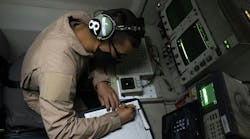By Ben Ames
TAUNTON, Mass. - Army planners have approved a preliminary form of the Warfighter Information Network-Tactical (WIN-T) program, the Army’s next-generation battlefield communications network. That means the system is still on track for initial fielding in 2008.
WIN-T is a secure, high-bandwidth wireless communications network that will link battlefield soldiers to voice, data, and video on a single network. It will encompass intelligence, surveillance, and reconnaissance systems, as well as netted weapons and the Future Combat Systems (FCS).
In a larger sense, WIN-T will act as one of four enabling technologies in Pentagon leaders’ effort to “transform” today’s military into a smaller, faster, more lethal force.
In this vision, WIN-T and the Joint Tactical Radio System (JTRS) act as mobile battlefield networks, connected to two permanent, high-bandwidth pipelines-a terrestrial network called the Global Information Grid Bandwidth Expansion (GIG-BE) and an aerial network called the Transformational Satellite Communications system, or TSAT.
Army leaders pushed this plan forward when they approved plans in the preliminary design review (PDR), the “first draft” of the WIN-T system design, including the top-level architecture and key component technologies. The system replies on a combination of communications technologies, including third-generation cellular, wireless LAN, next-generation satellite, IP version 6, and voice over IP.
Now WIN-T is on schedule for a critical design review (CDR) in September followed by development test/operational test (DT/OT) in November.
The WIN-T contract, worth $7 billion through 2018, was awarded in September 2004 to a team of General Dynamics C4 Systems, in Taunton, Mass., and Lockheed Martin, Gaithersburg, Md. They report to the Army’s Communications and Electronics Command, Ft. Monmouth, N.J.
With the PDR accomplished, the General Dynamics/Lockheed Martin team will build a prototype WIN-T network, to be used for extensive field testing in November 2005. Completion of that test, combined with the upcoming critical design review milestone, are essential requirements in advance of Army authorization for low-rate initial production (LRIP) of the WIN-T system, scheduled for March 2006.
“This major milestone is an important step to achieving the vision of WIN-T: giving warfighters access to critical battlefield information, seamless connectivity to the global information grid, unified network operations, joint interoperability and security across a host of platforms and points of presence,” said Bill Weiss, vice president of future force programs for General Dynamics.
Throughout June and July, military planners in every branch have let contracts for new networks.
In July, Army officials awarded a $152 million contract to Lockheed Martin, Manassas, Va., to lead the development, integration and maintenance of Army Knowledge Online (AKO), the Army’s primary internal web portal.
With more than 1.8 million users worldwide, AKO is a web portal that gives soldiers access to dozens of logistics and combat support applications, secure e-mail and messaging, and volumes of information. The finished product will act as a soldiers’ entry point onto the Global Information Grid.
Lockheed Martin will team with Science Applications International Corp. (SAIC), of San Diego, Computer Sciences Corp. (CSC), of El Segundo, Calif., and other technology providers including Roundarch, New York City, Internosis, Greenbelt, Md., The Ambit Group, Reston, Va., and MicroLink, Vienna, Va.
In other deals, Navy leaders granted Computer Sciences Corp. a $75 million bid to provide information technology support for the Outside the Continental United States (OCONUS) Navy Enterprise Network (ONE-NET) Far East.
The system will replace most of the Navy’s disparate networks at fleet bases throughout the Far East, including Japan, Korea, Guam, Singapore, and Diego Garcia. Teaming with CSC are C4 Solutions LLC of Blythe, Ga., and Alpha Solutions Inc. of Mansfield, Md.
Another Navy contract names SYS Technologies in San Diego to a $3.8 million contract to help build the Multifunctional Information Distribution System (MIDS). Other team members include Anteon Corp. and Odyssey Systems Consulting Group.
MIDS is a jam-resistant communication system used to digitally transmit voice and data information between U.S. and allied aircraft, ships, and ground forces. MIDS also serves as a navigation aid by providing precise participant location and identification information as part of the tactical data exchanged.
Finally, Air Force leaders assigned a $25.7 million contract to Northrop Grumman Corp. Mission Systems segment in Reston, Va., to develop an airborne communications relay and information server.
Called the Battlefield Airborne Communications Node (BACN), it will help link relatively old radios and intelligence, surveillance and reconnaissance systems to new Pentagon networks.
The Northrop Grumman team includes the NASA Johnson Space Center in Houston; Raytheon Solipsys in Laurel, Md.; L3 Communications in Salt Lake City; Vanu Inc. in Cambridge, Mass.; Rockwell Collins in Cedar Rapids, Iowa; and ViaSat Inc. in Carlsbad, Calif. This project is administered by the Air Force Electronic Systems Center at Hanscom Air Force Base, Mass.


